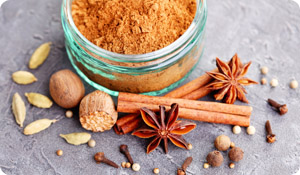
Brighten your holiday dishes with warm, fragrant spices for festive and delicious dishes. Unlike summer’s delicate flavoring agents, like dill and basil, cold weather spices are hearty and even pungent. They bring out the flavor in nogs, crisps, cobblers, and puddings, not to mention savory dishes likes roasts and casseroles. Want to know which ones to sprinkle over your food this winter? Here’s the flavor 411 on six of our faves.
Allspice
Native to South America and the West Indies, this isn’t actually a blend of “all spices” as the name implies, but is the dried berry of a type of evergreen tree. Its unique flavor, which is something like a mixture of cinnamon, cloves, and nutmeg, makes allspice in high demand in all kinds of baked goods as well as marinades and sauces (it’s used to make Caribbean jerk seasoning). You can buy it ground or whole, but the ground version is considerably easier to use.
May Help With: relieving muscle pain, cramps, and indigestion. Add a little allspice essential oil to bathwater to promote circulation and relieve muscle pain.
Cardamom
This pungent member of the ginger family hails from India but also grows in South America and Asia. While the seeds usually are removed from their cranberry-sized pods before being ground, sometimes the whole pod is ground.
Cardamom’s spicy-sweet flavor makes it a must-have for Scandinavian cookies, breads, and a variety of Indian foods, including chai tea. Add cardamom to pound cake, sugar cookies, and coffee cake, and it is especially good with figs and pistachios. Give homemade rice pudding an exotic flavor by flavoring it with a little cardamom.
May Help With: Stomach problems, and especially the sniffles. "Cardamom is often used to relieve symptoms of the common cold, cough, or respiratory inflammation," says Michele McRae, MS, CN, of Rainbow Light, a natural vitamin and supplement company in Santa Cruz, CA. For a soothing brew, steep cardamom pods in hot water tea before discarding.
Cinnamon
The most popular baking spice of all, cinnamon is the inner bark of a tropical evergreen tree and can be bought either in stick form or ground. Cinnamon comes in two varieties: reddish-brown cassia cinnamon is more pungent and typically is sold as cinnamon, while Ceylon cinnamon, also called tree cinnamon, is lighter in color and has a sweet flavor.
Choose stick cinnamon for flavoring drinks such as eggnog and coffee. If you’re planning to make mashed sweet potatoes or butternut squash for your holiday dinner, warm up the flavor with a little cinnamon. Or try storing a cinnamon stick in your ground coffee beans before brewing; the result is so delicious that your guests will want to know where you bought your coffee.
May Help With: Blood sugar management in people with type 2 diabetes.
Cloves
Pungent and robust, aromatic cloves are the dried, unopened flower buds of the clove tree and they lend their delicious flavor to all kinds of roasted meats, pies, gingerbread, and cookies. The flavor of cloves, which is native to Indonesia, is nicely complemented by both nutmeg and cinnamon. You can buy cloves either ground or whole; the latter look almost like tiny nails—in fact, the word cloves comes from the Latin word for nail: clavis.
May Help With: Protection against cancer.
Ginger
Noted for its anti-inflammatory properties and first cultivated in South Asia, this root is delicious both fresh, dried, including candied or crystallized, and powdered. It has a warming, almost citrusy flavor that makes it a natural in a wide variety of holiday desserts, including gingerbread and gingerbread cookies, of course! It’s also an ingredient in many Asian dishes.
May Help With: Indigestion and nausea. "Ginger enhances digestion," McRae explains. "Clinical studies have shown ginger to be effective in relieving nausea and vomiting during the first two trimesters of pregnancy." Try steeping quarter-size slices of fresh ginger in boiling water for 15 minutes. Add a little lemon, if you like.
Nutmeg/Mace
Both these spices come from the same tree, though nutmeg is ground from the seed and mace comes from the seed’s covering. Nutmeg, which is slightly sweeter, is delicious in eggnog, lattes, and espresso. Sprinkle nutmeg into rice pudding, add it to holiday apple and pumpkin pies, and stir a little into mashed butternut or acorn squash. Thanks to its slightly pungent flavor, mace is an important ingredient in a variety of fruit dishes and baked goods. It also enhances the flavor of many stews.
May Help With: Your teeth. Nutmeg may help prevent cavities, and it’s a good source of anti-inflammatory substances that may offer protection against some cancers.
Alison Massey, MS, RD, CDE, LDN, of Mercy Medical Center in Baltimore, MD, reviewed this article.
Sources
Michele McRae. Email interview, November 25, 2014.
Kaefer, Christine M. and John A. Milner. "Herbs and Spices in Cancer Prevention and Treatment." Benzie, IFF and S. Wachtel-Galor, editors. Herbal Medicine: Biomolecular and Clinical Aspects. Second Edition. Boca Raton: CRC Press, 2011. National Institutes of Health.
"Cinnamon May Help Improve Blood Glucose Levels in Type 2 Diabetes." American Diabetes Association. Page last edited October 7, 2013.
Lei Zhang and Bal L. Lokeshwar. "Medicinal Properties of the Jamaican Pepper Plant Pimenta dioica and Allspice." Current Drug Targets 2012 13(14): 1900–1906.
Aggarwal, Bharat B, Sahdeo Prasad, Simone Reuter, Ramaswamy Kannappan, Vivek R. Yadev, Byoungduck Park, Ji Hye Kim, Subash C. Gupta, Kanokkarn Phromnoi, Chitra Sundaram, Seema Prasad, Madan M. Chaturvedi, and Bokyung Sung. "Identification of Novel Anti-inflammatory Agents from Ayurvedic Medicine for Prevention of Chronic Diseases: ‘Reverse Pharmacology’ and ‘Bedside to Bench’ Approach." Current Drug Targets 2011 12(11): 1595–1653.





